Flaka
The Flaka is basically an aerial windward 360 with the move initiated by bearing off the wind. Before this move was invented there was a wave maneuver called the Taka. This move looks like a flatwater Taka, hence the name Flaka gradually emerged from the windsurfing cicles. The talented Web Pedrick was the first Professional to stick this maneuver after being inspired by the "2001 Move Innovation" competition held in the Gorge, Oregon and hosted by Lars Bergstrom. Web named the move after the actor Patrick Swayze but the name has lost favor to the Flaka. Learning this maneuver, so to speak, completes the essential freestyle trilogy - Spock, Grubby, Flaka. Having this trilogy at your command, on both starboard and port tacks, will surely keep you out of the cellar during freestyle competitions.

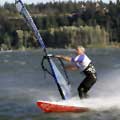


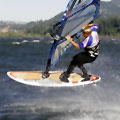


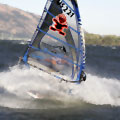

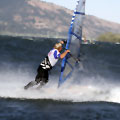


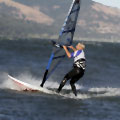
Rider: Royn Bartholdi
Steps
 1)
Begin by bearing off wind with a great deal of speed. Look for some chop or small ripples in the water to facilitate the board jump. Reaching your back hand on the boom will help with this move and some sailors like to move the front hand back on the boom as well. So both hands will be further back on the boom than you normally sail.
1)
Begin by bearing off wind with a great deal of speed. Look for some chop or small ripples in the water to facilitate the board jump. Reaching your back hand on the boom will help with this move and some sailors like to move the front hand back on the boom as well. So both hands will be further back on the boom than you normally sail.  2)
Now oversheet the sail and bear further off wind. Your eyes are looking in the area downwind where you want the nose of the board to land.
2)
Now oversheet the sail and bear further off wind. Your eyes are looking in the area downwind where you want the nose of the board to land.  3)
Bend your body in a crouched position to jump the board out of the water. Pull the clew hand slightly back.
3)
Bend your body in a crouched position to jump the board out of the water. Pull the clew hand slightly back.  4)
Flatten the board so popping the board out of the water is easier then quickly jump the board out of the water (causing your legs to go straight and hips to go forward) and aggresively bring the sail across your body. learning the timing of popping and bringing the sail neutral across your body takes practice and is critical for the success of making this Move.
4)
Flatten the board so popping the board out of the water is easier then quickly jump the board out of the water (causing your legs to go straight and hips to go forward) and aggresively bring the sail across your body. learning the timing of popping and bringing the sail neutral across your body takes practice and is critical for the success of making this Move.  5)
While in air push the front hand straight while keeping the reard hand bent -- this is known as the bow and arrow arm position. Also, pull the back foot up toward your buttocks. The idea is to to force the nose back to the water with your body positioned over the centerline over the board and the mast leaning forward. There is a tendency to push out with the reard hand -- Do NOT PUSH OUT with the rear hand because it kills the move.
5)
While in air push the front hand straight while keeping the reard hand bent -- this is known as the bow and arrow arm position. Also, pull the back foot up toward your buttocks. The idea is to to force the nose back to the water with your body positioned over the centerline over the board and the mast leaning forward. There is a tendency to push out with the reard hand -- Do NOT PUSH OUT with the rear hand because it kills the move.  6)
Keep your front arm extended as the board lands and slides on the nose. Notice my front hand is still extended and back hand bent.
6)
Keep your front arm extended as the board lands and slides on the nose. Notice my front hand is still extended and back hand bent.  7)
Keep your front arm extended as the board lands and slides on the nose. Notice my front hand is still extended and back hand bent.
7)
Keep your front arm extended as the board lands and slides on the nose. Notice my front hand is still extended and back hand bent.  8)
The sail will become backwinded and the rest of the move is pretty much on auto-pilot if you can do Upwind-360s. Keep the front hand straight, sail close to body, and back hand bent.
8)
The sail will become backwinded and the rest of the move is pretty much on auto-pilot if you can do Upwind-360s. Keep the front hand straight, sail close to body, and back hand bent.  9)
Ditto... Enjoy the ride and begin to look over your shoulder in the direction of the spin.
9)
Ditto... Enjoy the ride and begin to look over your shoulder in the direction of the spin.  10)
Ditto...
10)
Ditto...  11)
Push out with the clew hand and drop your weight over the back leg so the ending of the move now swithes to rotating around the tail.
11)
Push out with the clew hand and drop your weight over the back leg so the ending of the move now swithes to rotating around the tail.  12)
Reposition and regain control of the sail.
12)
Reposition and regain control of the sail.  13)
Trim and sail away.
13)
Trim and sail away. Videos
Loading the player ...
This is a variation of the standard Flaka in which the rider does not bury the nose in the water but rather lands the board flat and uses the inertia of throwing the body and rig windward to complete the move. It works! Often though, this is where beginners get hung up because they try to twist into the wind instead of throwing themselves over the centerline of the board. There are many styles and variations to every move. I guess there is no absolutely correct way
All Contents Copyright © 2008-2025 Royn Bartholdi. All Rights Reserved